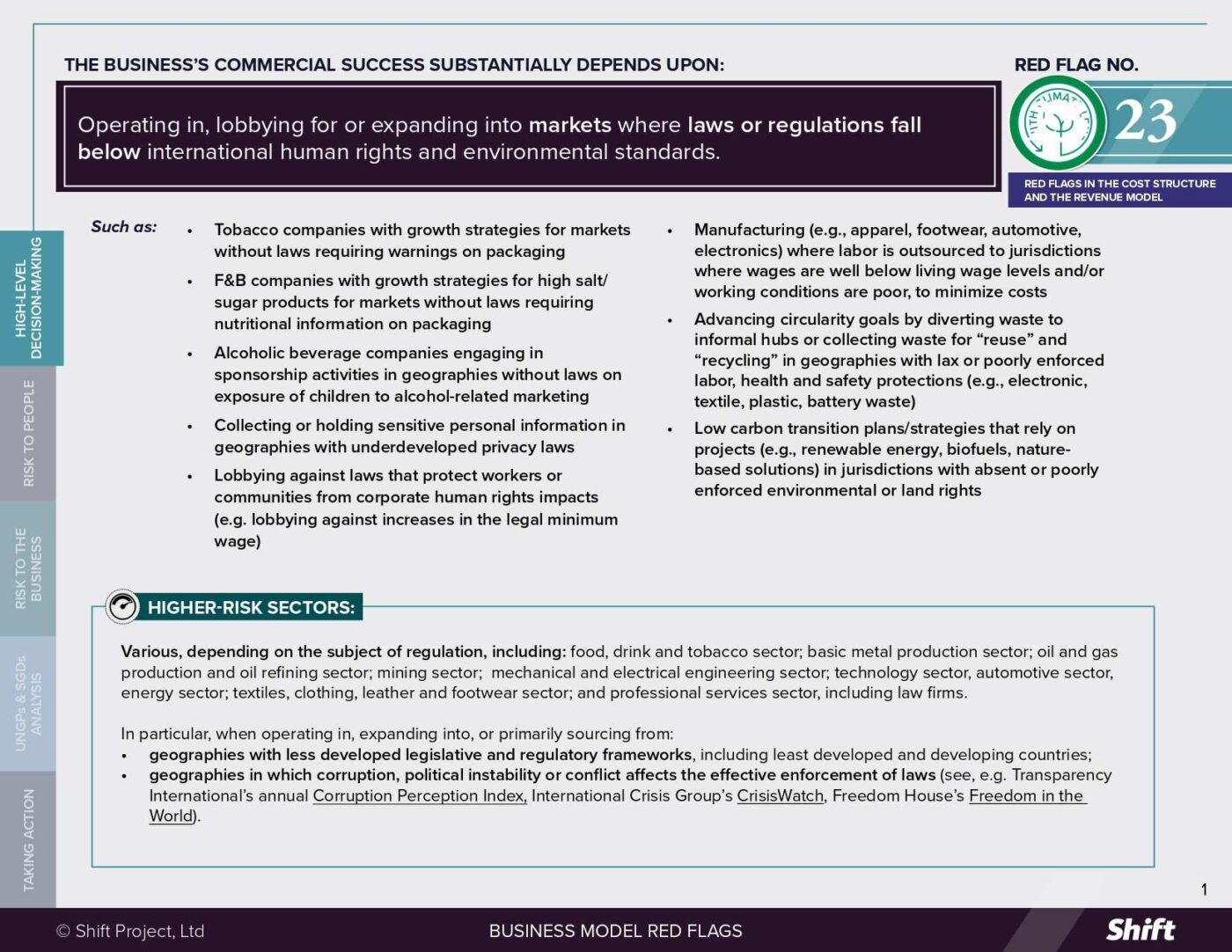On February 15, 2017, Shift Chair and author of the UN Guiding Principles John Ruggie delivered a keynote address to the G20 Labour and Employment Meeting in Hamburg. He was accompanied by Shift’s President, Caroline Rees. The complete text of Professor Ruggie’s address is below.
Also see: Shift position paper on the connection between the UN Guiding Principles and the Sustainable Development Goals | Our short framework for action that any company should and can follow to contribute to the SDGs
I am deeply honored to have been asked to join you here this morning. And I wish you every success on your critical mission to promote socially sustainable supply chains.
This subject could not be more important – for individual countries that participate extensively in global supply chains, and for the future of the open global economy itself. These vast and complex networks crisscrossing the world are the nexus between investment and trade. They are vulnerable today, and the global economy along with them. However, their effective management can turn them into significant leverage points to make globalization work better for all. Addressing this challenge requires the kind of collective leadership that only the G20 can provide.
As in a volcano, a potential rupture has been building up steam for quite some time. As far back as January 1999, then UN Secretary-General Kofi Annan warned, in a World Economic Forum address, that unless globalization has strong social pillars it will be fragile: “vulnerable to backlash from all the ‘isms’ of our post-cold war world: protectionism; populism; nationalism; ethnic chauvinism; fanaticism; and terrorism.” He added that if we cannot make globalization work for all, in the end it will work for none. Today we neither need, nor should we want, any additional evidence of Annan’s prophetic insight. We see it all around us.
I propose to do three things this morning. The first is to describe briefly some key dimensions of global supply chains. Second, while acknowledging the enormous economic contributions they have made, I also flag several fundamental problems. Third, I explain how the UN Guiding Principles for Business and Human Rights contribute to achieving socially sustainable supply chains.
Here is an example of a global supply chain network. Like some of you, I have an iPhone 6. It was designed by Apple in the United States, and assembled by Foxconn, a Taiwan based company at its operations in China. Along the way, the components were produced by 785 suppliers in 31 countries. Some are multinationals in their own right, with their own supply chains. It turns out that this is at the smaller and simpler end of the global supply chains spectrum.
It should be stressed that global supply chains are rapidly ceasing to fit the traditional profile of suppliers in the Global South and buyers in the North. One of the most profound global geo-economic shifts today is the rapid increase of transnational corporations based in emerging markets and developing countries. In the year 2000 they numbered just 12 on the Fortune Global 500 list. In 2010 the number had risen to 85. By 2025 their number is expected to reach 230, or nearly half of the entire FG 500.
One consequence of the global fragmentation of production processes is that world trade in intermediate goods is now greater than all other non-oil traded goods combined. This is due to the multiple times intermediate goods are imported, a step or two is taken in their processing, and then they get exported again as intermediate goods to the next stop, where the cycle is repeated until final assembly. Even more striking, about 80 percent of global trade (in terms of gross exports) is now linked to the production networks of multinational firms. Thus, trade is no longer simply arms length exchange between countries, governed by international trade law and policy. Much of it takes place among corporate entities, determined by their optimization strategies.
We may well be talking about one billion people worldwide involved in and directly affected by global supply chains. So in terms of orders of magnitude, the challenge of securing socially sustainable supply chains ranks high on the must-do list.
On the employment side, according to an ILO report one out of seven jobs worldwide is related to global supply chains. That number does not encompass so-called non-standard forms of work, which can range from casual and temporary employment to forced and bonded labor, nor does it include informal work at the bottom of supply chains, often done by women and children in the home. In the 17 G20 countries for which there is data, the percentage of the labor force in global supply chains is even higher: more than one job in five.
When we add up these numbers and recognize that those workers may have families who depend on them, we may well be talking about one billion people worldwide involved in and directly affected by global supply chains. So in terms of orders of magnitude, the challenge of securing socially sustainable supply chains ranks high on the must-do list.
This model of distributed production and service provision has transformed the world for the better. In developing countries, it has helped pull more countries and people of poverty, and faster, than in any other era of history. It has provided work opportunities for women that they lacked previously. In the industrialized countries, it has kept consumer prices low and helped keep inflation in check. And it has generated extraordinary technological innovations across all spheres of the human experience.
So why is there such concern today about the sustainability of this system? What’s the problem? The answer is that an enormous governance gap has been created: between the scope and impact of economic forces and actors, and the capacity of societies to manage the adverse consequences. The gap will be narrowed one way or another: either through more effective cooperation or through rollback, otherwise known as protectionism. I vote for cooperation, and I hope you will as well.
One corrosive consequence of this governance gap has been rapidly escalating income inequality within countries, even as income inequality among countries has declined.
Neither the income inequality nor the base erosion and profit shifting associated with the current structure of corporate globalization are socially sustainable.
Another such consequence is what the G20 and the OECD call “base erosion and profit shifting,” or BEPS. This refers to the highly sophisticated means whereby many multinationals are able to keep their effective corporate tax rates as low as the single digits through a combination of transfer pricing and booking foreign direct investments in tax havens, where the bulk of the profits then reside.
Former US Treasury Secretary Lawrence Summer, once a vigorous advocate of unfettered globalization, now writes that this is “a significant problem for the revenue capacity of states” —and he means all states. As a result, tax burdens increasingly fall on small businesses that cannot avail themselves of such strategies, and on individual households, while governments are strapped for resources to provide sufficient levels of public goods.
Neither the income inequality nor the base erosion and profit shifting associated with the current structure of corporate globalization are socially sustainable.
Other significant risks exist. In some developing countries, the further down the layers of suppliers one moves the more precarious work can be. Risks are worsened where governance is weak or poor: health and safety, inadequate wages, the worst forms of child labor, bonded labor and in some sectors slave labor. Multinationals are reasonably good at monitoring top tier suppliers, but in many cases no one really knows where the bottom is. That is not sustainable either.
At the same time, in some industrialized countries recent developments demonstrate what happens when the needs of people who have been left behind by offshoring and rapid technological change are ignored, on the assumption that somehow the magic of the marketplace will self correct. Wrong. It is the global marketplace that becomes the target of their animus. This too poses a serious risk to sustainable global supply chains, indeed to globalization writ large.
So where do we go from here? What opportunities exist to generate positive change? One promising scenario is sketched out in the report of the Business and Sustainable Development Commission, launched at Davos last month. The Commission includes CEOs of leading companies headquartered in China, India, Saudi Arabia, South Africa, Turkey, as well as the US and Europe.
The Commission’s research suggests that achieving the UN Sustainable Development Goals (SDGs) could add $12 trillion a year to business savings and revenue in just four economic areas alone: food and agriculture, energy and materials, health and wellbeing, and sustainable cities. The Commission estimates that the economic prize from fully implementing the SDGs could be two to three times bigger, if the benefits are captured across the whole economy and are accompanied by higher labor and resource productivity. I’m not a mathematician, but those seem like big numbers!
The Commission lays out six action paths, one of which is to “Rebuild the Social Contract.” Where does this rebuilding begin? Here is what the Commission says:
Treating workers with respect and paying them a decent wage would go a long way to building a more inclusive society and expanding consumer markets. Investing in their training, enabling men and women to fulfill their potential, would deliver further returns through higher labor productivity. And ensuring that the social contract extends from the formal to the informal sector, through full implementation of the UN Guiding Principles on Business and Human Rights, should be non-negotiable.
This brings me to my final point. What are these Guiding Principles, and where did they come from? I had the honor to develop them over a six year mandate as the UN Secretary-General’s Special Representative for Business and Human Rights. They comprise three sets of mutually reinforcing principles: the state duty to protect against human rights abuses by third parties, including business; the corporate responsibility to respect human rights; and the need for greater access to effective remedy by those who have been adversely affected by business conduct.
The UN Human Rights Council unanimously endorsed the Guiding Principles in June 2011. They constitute the only official guidance the Council and its predecessor, the Commission on Human Rights, have issued for states and business enterprises on their respective obligations in relation to business and human rights. The five core sponsors of the resolution to endorse the Guiding Principles were Argentina, India, Nigeria, Norway and the Russian Federation.
UN High Commissioner for Human Rights, Zeid Ra’ad Al Hussein, describes the Guiding Principles as “the global authoritative standard, providing a blueprint for the steps all states and businesses should take to uphold human rights.” They have been widely drawn upon in standard setting by other international organizations, governments, businesses, law societies including the International Bar Association, and even FIFA, the global governing body of football. The China Chamber of Commerce of Metals, Minerals & Chemical Importers & Exporters has issued detailed recommendations for the overseas conduct of Chinese mining companies based on the UN Guiding Principles. The Indian government’s Voluntary National Guidelines embrace key elements of the UN Principles, and its top 500 listed companies must report against how they respect human rights. Among the G20, Germany, Italy, the UK and the US have issued National Action Plans to implement the Guiding Principles. Argentina, Brazil, Indonesia, Japan and Mexico have committed to do so or already have begun the processes.
The Guiding Principles provide a roadmap for helping to bridge the governance gaps and imbalances that must be addressed for global supply chains and globalization itself to become socially sustainable.
These examples demonstrate that a growing number of governments, businesses and other actors recognize how the UN Guiding Principles can play a central role in achieving socially sustainable business – and by extension – sustainable development.
First, the Guiding Principles help companies to identify human rights risks along their entire supply chains, through an approach that reduces harm and creates social value. They do so by outlining the components of a human rights due diligence process enabling companies to manage the adverse impacts on people of their own conduct and their business relationships. The components include companies assessing potential and actual impacts, and acting on that information.
Second, the Guiding Principles highlight the many ways in which governments can incentivize responsible business conduct and protect people from human rights abuse by business. This requires a smart mix of policies at the legislative and regulatory levels, as well as governments taking these factors into account when they support or otherwise do business with business.
Third, the Guiding Principles identify key means through which both business and governments need to ensure access to effective grievance procedures and remedy for the inevitable scenarios where people – typically the poorest and most vulnerable – suffer the results of abusive business practices. This involves judicial and non-judicial state-based processes, as well as operational level grievance mechanisms companies can establish or participate in.
In short, the Guiding Principles provide a roadmap for helping to bridge the governance gaps and imbalances that must be addressed for global supply chains and globalization itself to become socially sustainable.
Much is at stake for countries and people. But we can make globalization work for all by putting human dignity at its center. And you, as member states of the G20, have a unique opportunity to take the lead by supporting action on the important agenda that is before you at today’s session, and urging businesses and governments to advance the further implementation of the Guiding Principles.
Thank you, and once again the very best wishes for success.
 By John Ruggie
By John Ruggie



